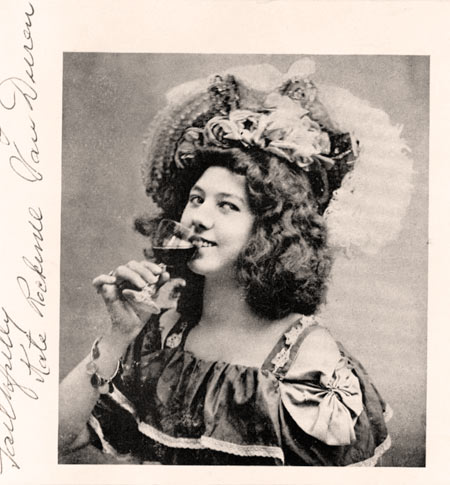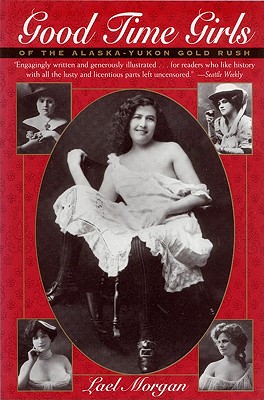Gold Rush

(Klondike Kate, circa 1906 in Dawson. Photo Virtual History)
While I was tapping my toes waiting for the Comcast guy to come last night, “between five and eight” I started to read a great history of the Klondike Gold Rush. It had been sitting on the shelf for a couple years, but my interest was recently piqued by the rebound of the gold exploration industry in the frozen northland.
When I started it, the world was bright, and I was able to sit out on the porch and catch the last of the sun with my shirt off. The life guard was an old guy, apparently another American temp filling the gap since the volcanic ash plume from Iceland has delayed the arrival of the Eastern Europeans who normally rule the Big Pink pool deck through the high summer.
There is another gold rush in progress, for all the usual reasons. Gary Wolf wrote a fabulous article about the new Yukon gold rush in a recent New York Times magazine article. He says what is going on today up in the Northwest Territories of Canada, and across the border in Alaska is the biggest since the Klondike stampede a century ago.
In fact, that is why my sister Annook lives up there. Her husband in the late 1970s got the fever and moved them up to Alaska when inflation was out of control and people thought Krugerrands were the hedge against interest rates that were in the teens.
In 1980, gold was over $800 an ounce. They made a pretty good living for a while working old Klondike claims, shoveling out the tailings the old-timers had left behind and scavenging the nuggets they missed.
There were flush times up there, but with stability the air came out of the bubble and the price per ounce tumbled to below $400.
The whole thing was about fear, of course, as Wolf points out his fascinating profile of the people who stuck it out after inflation was reigned in and gold prices tumbled. Some made a pretty good living in mushrooms, for example, but the gold bugs are back.
As Mr. Bernanke at the Fed keeps interest rates near zero in an attempt to stimulate the economy, the gold bugs are making apocalyptic predictions of what is going to happen to the value of the dollar. Consequently, one of the conventional wisdoms holds that the crushing federal deficit will cause the economy to collapse amid hyperinflation.
The thinking goes that gold will hold its value as the national currencies of America and the EU collapse.
It is an interesting line of reasoning, as we contemplate the abyss. Gold is easily imported, widely traded and the brand recognition is universal. Such renowned intellects as Glen Beck and Laura Ingraham are hawking the noble metal as the “perfect investment for the apocalypse.”
I am getting weary of the end of the world. All the squirrels are out, and like assholes, all of them has an opinion on how this is going to go.
I have to admit that I wish I had climbed on the panic train a long time ago. Gold passed $1,500 an ounce, nearly double the last panic spike level, even though smart guys have been warning that a bubble was being created at the $1,000/oz. level.
Some of the Bugs are talking about $2,000 gold, $5,000 gold, even $10,000 gold.

(Good Time Girls, by Lael Morgan.)
Anyway, that is why I pulled down “Good Time Girls” by Lael Morgan, an astonishingly rich 1998 work of research on the ladies of the Klondike Gold Rush.
As it turns out, hookers were the first women to arrive in the goldfields. Since the patriarchy of the day precluded them from hard labor in the field (pants or bloomers were prohibited by force of law, for example) the intrepid ladies of the demimonde simply did the next best thing and “mined the miners.”
The crushingly hard life of women in ordinary life as maids, laundresses or homemakers made the alternative of being a fancy girl a viable career move in the far north, or at least that is the conclusion of Ms Morgan, who spent thirty years looking at the period and its remaining evidence.
As now, fortunes then were made and blown overnight. The most reliable means of securing wealth came from stoking the fever that came with the notion that gold was lying on the ground for the taking, and then peddling goods to the dreamers with the shovels.
I got hooked on the accounts of the hardship of that life, and of the names of the places. Skagway, Nome, Circle City, Forty Mile and Dawson. They say that there were a couple hundred thousand people involved in the stampede, overwhelmingly male, and with real fortunes on the line and a brief summer book-ended by an eight-month winter with temperatures that plunged to -70 degrees below zero.
As I looked up periodically at the clock to see whether I could get my swim in after the Comcast technician came, I had to contemplate that generation of Americans and Canadians who fled the long depression down below and struck out for the goldfields. Ms Morgan describes them like this: “brawny, in their prime, optimistic, happy to be out from under the apron of the Outside.”
Morals and probity under Miner’s law were rough and situational, sort of like Comcast’s version of customer service. As eight o’clock came and went, I put the book aside and sighed. I began the excruciating process of attempting to contact the service desk. You know the drill- eighteen or twenty “press-one-or-four,” on hold, and the finally the story from the operator: “No equipment, so no service.”
“And no notification. You guys have no qualms about Robo-calling me two or three times to ensure I am home.”
“Well, as you know, the time of our technicians is valuable, and for your inconvenience, we are prepared to offer you a $20 dollar credit.”
“Do you know how much gold dust that can buy you?” I asked. Then I made a suggestion as to where the telecommunications giant might insert their credit.
“Thank you for using Comcast,” went the line, like there is a freaking choice.
I knew I could not get a work-out swim in before the pool closed, but a plunge in the cool water might take the edge off my frustration with the communications monopoly. I arrived at 2045, fifteen minutes to go, and saw the gate locked and the lifeguard gone.
“Freaking Americans!” I fumed aloud to Joe and Mary Margaret, who were relaxing in the sweltering darkness on Joe’s patio.
“If you need to find someone who works anymore you have to find a Mexican or a Pole.”
Copyright 2011 Vic Socotra
www.vicsocotra.com
